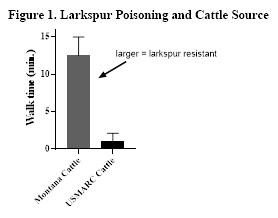Project Overview
Commodities
- Additional Plants: native plants
- Animals: bovine
Practices
- Animal Production: animal protection and health, grazing management, rangeland/pasture management
Proposal abstract:
Larkspurs (Delphinium spp.) are native plants that grow on foothill and mountain rangelands of western North America and have a long history of poisoning grazing cattle. Ranchers who graze cattle in rangelands with large populations of toxic larkspur often have yearly herd mortalities up to 10%. These losses amount to millions of dollars due to animal deaths, increased management, and veterinary treatment costs.
We propose to compare animals from a herd grazed on larkspur-containing pastures (larkspur-native) to cattle from a herd that has never been exposed to larkspur (larkspur- naive). We hypothesize that fewer larkspur-native animals will be lost to larkspur poisoning than larkspur- naive cattle.
The sourcing of replacement cattle from larkspur-native herds could be a simple and sustainable solution for reducing cattle losses and increase the profitability of cattle production on larkspur-infested rangelands. The results from this study will have regional impacts that will affect producers throughout the western U.S. Livestock death losses cause undo stress on livestock owners and reducing that worry and stress by knowing the livestock that are grazing larkspur-infested rangelands are resistant to the plant alkaloids can help enhance the quality of life for livestock producers.
The outcomes from this study will be disseminated through extension fact sheets, a field day, presented at scientific and producer meetings, and a peer-reviewed publication.
Project objectives from proposal:
The objective of this study is to test the hypothesis that fewer larkspur-native animals will be lost to larkspur poisoning than larkspur-naive cattle. After the grazing season, surviving cattle will subsequently be tested for larkspur resistance at the PPRL as previously described (Green et al., 2014), to determine their larkspur phenotype and genotype. The phenotypes and genotypes will be incorporated into a genetics of larkspur resistance in cattle study currently underway at the PPRL (genotyping costs will be paid by the PPRL).

To complete this objective, grazing studies will be conducted when larkspur is growing and toxic to cattle (May 1 to October 1). Twenty Angus steers, that have not been preselected due to culling practices, and are naive to larkspur poisoning and twenty Angus steers from ranches that have historically preselected animals, due to culling practices, that are more resistant to larkspur (native) will graze together. Preliminary research (Figure 1) with six larkspur-naive Angus steers from the US Meat Animal Research Center, Clay Center, NE (USMARC) had a shorter exercise times after receiving an oral dose of dried ground larkspur compared to the exercise times of twenty-six larkspur-native Angus steers from Montana that received an oral dose of larkspur. The cattle were exercised 24 hours after the oral dose of dried ground D. barbeyi. Larkspur resistant cattle walk longer than larkspur susceptible because the toxins in larkspur cause muscle weakness and resistance to exercise (Green et al., 2019a).